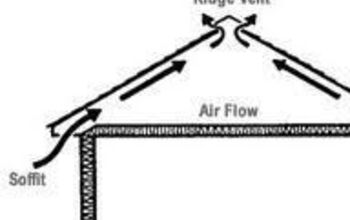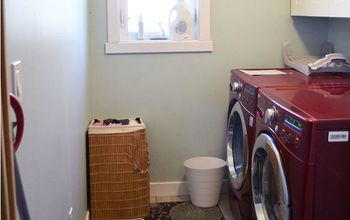Can no venting on a roof result in a HOT house - in the summer?

-
@Carol S It seems logical to think they would help. When we had our roof re-done the roofer suggested adding more vents due to the size of our roof. I do know that trapped heat and humidity can create other issues in the attic like wood warping and mold.
 Dee W
on Jul 18, 2013
Helpful Reply
Dee W
on Jul 18, 2013
Helpful Reply -
-
Adequate ventilation is needed to reduce heat build up in the attic space and protect the life expectancy of your roof. Visit Owens Corning website for information on vents and sizing
 Euroshake
on Jul 18, 2013
Helpful Reply
Euroshake
on Jul 18, 2013
Helpful Reply -
-
Yes, having ridge vents should help. Outside air should flow in through the soffit vents and the heated air should flow out through the ridge vents. If the air is trapped, the heated air can radiate into the house through the ceiling. See the diagram below. www.roofingbycurry.com
 ROOFING BY CURRY Sarasota Roofing Contractor
on Jul 19, 2013
ROOFING BY CURRY Sarasota Roofing Contractor
on Jul 19, 2013
 Helpful Reply
Helpful Reply -
-
Venting is good but so is the proper amount of insulation between the hot attic space and your conditioned space below. Your should have R49 to R60 up there for your location. Most older homes are really weak in this area, do you know what is up there now?
 KMS Woodworks
on Jul 19, 2013
Helpful Reply
KMS Woodworks
on Jul 19, 2013
Helpful Reply -
-
Carol, ventilation is critical and most contractors overlook this aspect of the home. Intake and outtake should be equal to each other to create the proper amount of pressure and airflow. If heat buildup occurs in the attic, not only are you going to get that heat radiating back into your home, but it is going to bake your sheathing, underlayment and roofing material from the underside, causing it to age much quicker than normal. Here are a couple of links for two of our favorite ventilation manufacturers to help you calculate the amount of proper intake and outtake with your local contractor. http://www.gaf.com/Roofing/Residential/Products/Roof_Vents/Ventilation_Calculator and http://ohagin.com/calculator.asp Hope this helps you and let us know if we can be other any other service! Chandler's Roofing www.chandlersroofing.com
 Chandler's Roofing
on Jul 19, 2013
Helpful Reply
Chandler's Roofing
on Jul 19, 2013
Helpful Reply -
-
Thanks everyone - We definitely have to get additional venting put in. Pete was told by the inspector that he has too much insultion in the attic. Does that matter?
 Carol S
on Jul 19, 2013
Helpful Reply
Carol S
on Jul 19, 2013
Helpful Reply -
-
Too much insulation? How much does he have up there? R-60 is a pretty thick bed.
 KMS Woodworks
on Jul 20, 2013
Helpful Reply
KMS Woodworks
on Jul 20, 2013
Helpful Reply -
-
Ridge vents work if there is enough ridge to put it on. On a Hip roof with little ridge I recommend Attic fans and depending on how big the attic is I would put in more. Not much electricity is used and they do great. Lowes sells a lifetime one that we use and if it ever goes bad take it back and they will replace it for free. Not the installation. Also it is important with attic insulation to make sure there are Baffles between the rafters so the attic can ventilate properly! R 30 is what is recommended in Charleston SC.
 Witte Construction LLC
on Jul 20, 2013
Helpful Reply
Witte Construction LLC
on Jul 20, 2013
Helpful Reply -
-
Carol, your getting great information on this, however there is one more thing you need to understand. while ventilation is important in some cases air sealing is even more so. If an attic is properly vented, ideally with ridge and soffit vents extending the entire length there is really nothing more you need to do. If you have roof vents or gable vents (on the ends) plus soffit vents you should be still fine. The issue is when you install roof vents and do not have enough soffit vents to provide the air needed to rise up and out. This results in a negative air pressure within the attic space. But the air needs to come in after all it is going out. This make up air of sorts is coming from inside the house. Through the walls, light fixtures, from the wall sockets and switches and even from the basement or crawl areas below. Walls are hollow in the middle of the house. They have direct connection to the floors above or in your case the attic. Electrical contractors, plumbers, HVAC folks punch holes all over your home when its being constructed. While these tiny holes by themselves do not amount to very much, combined they can result in openings as large as a small window being left open. Furthermore, and why knowing this is important. Think of insulation as a sweater you wear on a cool evening. Feels great right? But that slight breeze comes off of the water and you get a chill. This is the breeze removing the heat from between the fibers that is keeping you warm. Well the same thing happens with insulation. Adding several inches or feet to the insulation is great, but as soon as air blows through it, the heat is removed and the house feels hot or cold again. The ideal attic would have all the insulation removed, then using spray foam in a can every exposed wall would be sealed where you see the drywall or plaster meeting the wooden plate. Very important to do along the outside edges of the walls as well. Lots of air moves through this area. This is one reason you see all those icicles hanging off of the gutters and edges of homes during the winter months. Its the warm air rising up from those wall plates that is melting the snow. In the past we were taught just to install baffles to redirect the soffit air into the attic so it would not be blocked by the insulation installed along the edges. But the air that still flows freely up the outside walls does not stop and will continue to cause those ice dams. Areas around light fixtures are also big energy wasters. Foam those boxes tight. If you have recessed light fixtures, you need to convert them over to LED or CFL bulbs. Then box them in with foam boards and foam them into place. Every pipe that enters into the attic should be sealed tight. Chimneys are really important. However you do not want to foam around them. You need to use metal flashing's cut and nailed tight against the chimney space. Then using high heat caulking seal the cracks to prevent air movement. In all your trying to stop air from entering into your attic. The tighter you make it from leaks below the better the insulation will work. You can add several feet of insulation on the floor. And that is good, but if you do not stop the air leaks into the attic, you simply will end up with discomfort below, plus moisture issues in and within the attic insulation causing mold and decay. Attic fans? Forget it. These devices are often installed because of lack of natural air entering the attic. While they will pull more air into what ever vents you have, they will also pull large quantities of air out of the house. The very air your trying to clean and heat or cool. Remember any air that leaves more air needs to come in. So if your house is leaking air into the attic, and it is, that air needs to come into the living area to make it up. This is the air that bypasses your air cleaning devices, and your heating and cooling equipment. Resulting in drafts, dusty homes, higher allergy issues if you suffer plus high energy bills. The ideal way to insulate is to completely foam the entire roof and side walls. R-30 foam about eight inches or so thick will make your attic about 10 degrees warmer then what your living area is at. Having done several of these, I can tell you when were working on the clients AC system often located in these areas, the attic is really comfortable. It can become expensive to do this, but with state and federal programs these costs can be often reduced and written off on some taxes. So to answer your question, no, if you do not vent your attic, and you have enough insulation for the area you reside, and your attic floors are air sealed you do not need to add or change anything. As it will do nothing to increase the heat in the living area of the home.
 Woodbridge Environmental Tiptophouse.com
on Jul 23, 2013
Helpful Reply
Woodbridge Environmental Tiptophouse.com
on Jul 23, 2013
Helpful Reply -
Related Discussions
How to get rid of mice?
We seem to have some unwelcome Mickeys and Minnies in our house. What is the best way to get rid of them?
How to remove popcorn ceiling with asbestos?
I want to remove my popcorn ceiling, but it has asbestos in it. How do I go about this safely?
How to caulk baseboard gaps?
How do I fill gaps at baseboard, should I caulk? If so, does anyone know how to caulk baseboards?
How to fix squeaky hardwood floors?
How do I fix squeaky hardwood floors?
What are some tips to be Energy efficient?
What are some tips other than setting thermostats and placing plastic on windows for an energy efficient home? I am mainly looking at green solutions for heating and ... See more
Fan speeds vs energy consumption? ?
Does it save any electricity to run ceiling fans, box fans, dehumidifiers, etc on a lower speed?



